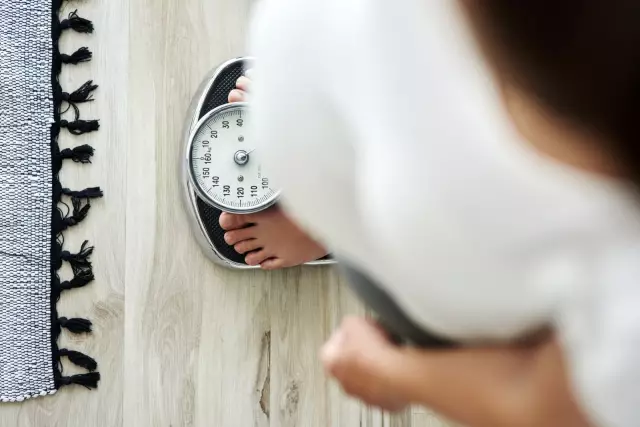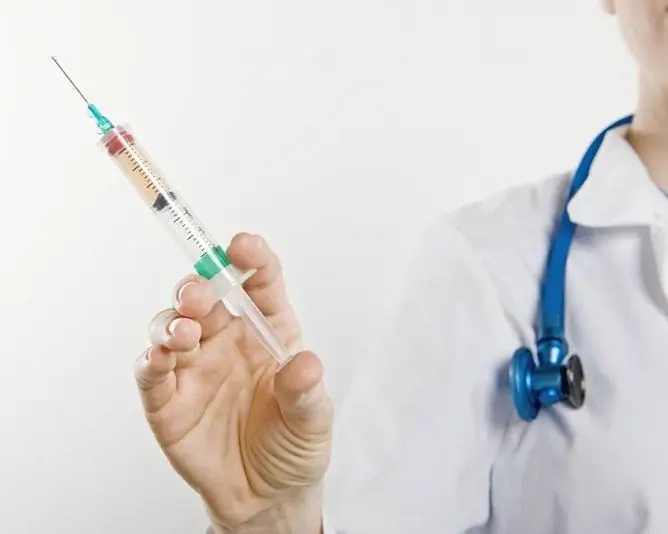- Author Rachel Wainwright [email protected].
- Public 2023-12-15 07:39.
- Last modified 2025-11-02 20:14.
Artoxan
Artoxan: instructions for use and reviews
- 1. Release form and composition
- 2. Pharmacological properties
- 3. Indications for use
- 4. Contraindications
- 5. Method of application and dosage
- 6. Side effects
- 7. Overdose
- 8. Special instructions
- 9. Application during pregnancy and lactation
- 10. Use in childhood
- 11. In case of impaired renal function
- 12. For violations of liver function
- 13. Use in the elderly
- 14. Drug interactions
- 15. Analogs
- 16. Terms and conditions of storage
- 17. Terms of dispensing from pharmacies
- 18. Reviews
- 19. Price in pharmacies
Latin name: Artoxan
ATX code: M01AC02
Active ingredient: tenoxicam (Tenoxicam)
Producer: Egyptian International Pharmaceutical Manufacturing Company (E. I. P. I. Ko.) (Egypt)
Description and photo update: 2019-10-07
Prices in pharmacies: from 429 rubles.
Buy

Artoxan is a non-steroidal anti-inflammatory drug (NSAID) for parenteral use. It has anti-inflammatory, analgesic and cyclooxygenase (COX) inhibiting action.
Release form and composition
The drug is produced in the form of a lyophilisate for the preparation of a solution for intravenous and intramuscular administration: green-yellow compacted tablet-like mass or powder; solvent - a transparent liquid that has no color or odor.
The lyophilisate is packaged in a colorless glass vial, sealed with a rubber stopper and crimped with an aluminum cap with a plastic red cap, the solvent is in a colorless glass ampoule of 2 ml. 3 vials with a lyophilisate and 3 ampoules with a solvent are placed in a blister strip packaging; a cardboard box contains 1 package and instructions for the use of Artoxan.
Composition for 1 bottle of powder:
- active ingredient: tenoxicam - 20 mg;
- auxiliary components: ascorbic acid, trometamol, mannitol, hydrochloric acid, sodium hydroxide, disodium edetate.
Water for injection acts as a solvent (2 ml in each ampoule).
Pharmacological properties
Pharmacodynamics
Tenoxicam is a thienothiazine derivative of oxicam. It belongs to NSAIDs. In addition to antipyretic, analgesic and anti-inflammatory activity, tenoxicam also inhibits platelet aggregation.
The mechanism of action of Artoxan is associated with the inhibition of the activity of isoenzymes COX-1 (cyclooxygenase-1) and COX-2 (cyclooxygenase-2), which leads to a decrease in prostaglandin synthesis in the inflammatory focus and other tissues and organs. Tenoxicam reduces the accumulation of leukocytes in the focus of inflammation, and also reduces the activity of collagenase and proteoglycanase enzymes in human cartilage.
The anti-inflammatory effect develops by the end of the first week of Artoxan therapy.
Pharmacokinetics
Absorption of tenoxicam is fast and complete. Bioavailability is 100%. 2 hours after administration, the maximum plasma concentration of the active substance is found in the blood.
A distinctive feature of tenoxicam is the ability for long-term action and a long T 1/2 (72 hours). About 99% of the drug binds to plasma proteins. Tenoxicam easily passes through histohematogenous barriers and enters the synovial fluid.
Metabolism takes place in the liver. As a result of the hydroxylation of tenoxicam, an inactive metabolite is formed - 5-hydroxypyridyl. Artoxan is excreted in the form of inactive metabolites (2/3 - by the kidneys and 1/3 - with bile through the intestines).
Indications for use
- ankylosing spondylitis (ankylosing spondylitis);
- rheumatoid arthritis;
- inflammation of the bursa of the joints (bursitis);
- osteoarthritis;
- inflammation of the synovial sheaths of the muscle tendon (tendovaginitis);
- articular syndrome with exacerbation of gout;
- traumatic and burn pains;
- mild to moderate pain syndrome (myalgia, headache and toothache, arthralgia, migraine, menstrual pain, neuralgia).
Artoxan is prescribed for the purpose of symptomatic treatment, reducing inflammation and pain at the time of application. The drug does not affect the course of the underlying disease.
Contraindications
Absolute:
- exacerbation of ulcerative colitis and Crohn's disease;
- erosive and ulcerative lesions of the duodenum and stomach in the acute phase;
- gastrointestinal bleeding (including a history of them);
- severe liver failure;
- severe renal failure (creatinine clearance less than 30 ml / min);
- progressive kidney disease;
- heart failure in the stage of decompensation;
- diseases of the blood coagulation system;
- the period before, during and after the procedure of coronary artery bypass grafting;
- complete or incomplete combination of intolerance to acetylsalicylic acid or other NSAIDs, polyposis of the paranasal sinuses and nose and bronchial asthma (including an indication of this combination in the anamnesis);
- children and adolescents up to 18 years old;
- During pregnancy and breastfeeding;
- increased individual sensitivity to the components of Artoxan (cross-sensitivity to ibuprofen, acetylsalicylic acid and other NSAIDs is possible).
Relative (Artoxan is used with caution):
- Crohn's disease and ulcerative colitis outside the period of exacerbation;
- peptic ulcer of the duodenum and stomach in chronic form;
- presence of Helicobacter pylori infection;
- hepatic porphyria;
- a history of liver disease;
- renal failure of mild or moderate severity (creatinine clearance from 30 to 60 ml / min);
- high blood pressure;
- chronic heart failure;
- a significant decrease in the volume of circulating blood (including serious surgical interventions);
- cardiac ischemia;
- peripheral arterial disease;
- diabetes;
- bronchial asthma;
- severe somatic diseases;
- hyperlipidemia / dyslipidemia;
- vascular diseases of the brain;
- autoimmune diseases;
- alcoholism, smoking;
- advanced age (over 65);
- long-term treatment with NSAIDs;
- co-administration with glucocorticosteroids, antiplatelet agents, anticoagulants and selective serotonin reuptake inhibitors.
Artoxan, instructions for use: method and dosage
Artoxan is administered intramuscularly or intravenously. The parenteral route of administration of the drug is intended for short-term therapy (within 1-2 days) at a dose of 20 mg once a day. If necessary, further treatment should be switched to oral forms of tenoxicam.
To prepare a solution for injection, the supplied solvent must be added to the contents of the lyophilisate vial. After preparing the solution, the needle is replaced.
The duration of the intravenous injection should not exceed 15 seconds. Intramuscular injections of Artoxan are carried out deep into the muscle.
Side effects
Undesirable systemic and organ disorders when using Artoxan (classified as follows: very often - ≥ 1/10, often - ≥ 1/100 and <1/10, infrequently - ≥ 1/1000 and <1/100, rarely - ≥ 1/10 000 and <1/1000, very rarely - <1/10 000, including isolated cases):
- gastrointestinal tract and hepatobiliary system: very often - stomatitis, NSAID-gastropathy, dyspeptic disorders (heartburn, nausea, vomiting, flatulence, diarrhea), anorexia, abdominal pain, abnormal liver function; often - an increase in the level of bilirubin in the blood serum and the activity of liver enzymes; rarely - bleeding (uterine, gastrointestinal, hemorrhoidal), ulceration of the mucous membranes of the gastrointestinal tract, perforation of the intestinal walls;
- cardiovascular system: rarely - tachycardia, heart failure, increased blood pressure;
- central nervous system and sensory organs: often - drowsiness, dizziness, tinnitus, headache, hearing loss, agitation, eye irritation, depression, visual impairment;
- urinary system: often - an increase in the level of creatinine in the blood and the content of urea nitrogen;
- hematopoietic system: often - a decrease in the number of leukocytes, agranulocytosis; rarely - a decrease in the number of platelets, anemia, pancytopenia;
- skin and subcutaneous fat: often - skin rash, erythema, urticaria, itching; very rarely - Lyell's syndrome, photodermatosis, Stevens-Johnson syndrome;
- laboratory test indicators: prolongation of bleeding time, an increase in the amount of bilirubin and creatinine in serum, an increase in the activity of liver enzymes, a high concentration of urea nitrogen.
During treatment with Artoxan, metabolic disorders and mental disorders are possible.
Overdose
With a single administration of large doses of Artoxan, the following overdose symptoms may occur: vomiting, nausea, impaired liver and / or kidney function, abdominal pain, metabolic acidosis, the formation of erosions and ulcers in the organs of the gastrointestinal tract.
In case of an overdose, standard symptomatic therapy is carried out, aimed at maintaining basic vital functions. Hemodialysis is ineffective, since the drug actively binds to plasma proteins.
special instructions
During the period of treatment with tenoxicam, it is necessary to monitor the function of the kidneys and liver, the parameters of peripheral blood, the level of glucose in the blood (in patients with diabetes mellitus) and the prothrombin index (when used simultaneously with indirect anticoagulants).
Artoxan injections should be canceled two days before the determination of 17-ketosteroids.
When carrying out surgical interventions, there may be an increase in bleeding time.
In the case of prescribing Artoxan to patients with heart failure and arterial hypertension receiving diuretics, water and sodium retention in the body is possible.
A history of kidney disease can cause the development of nephrotic syndrome, papillary necrosis and interstitial nephritis. The listed complications can be minimized by using Artoxan in the lowest effective doses and as short a course as possible.
Influence on the ability to drive vehicles and complex mechanisms
Artoxan can affect the speed of motor and mental reactions, therefore, during treatment, one should refrain from driving vehicles and engaging in other potentially hazardous activities that require a high concentration of attention and a quick reaction.
Application during pregnancy and lactation
Artoxan should not be used during pregnancy and lactation.
Pediatric use
It is not recommended to prescribe Artoxan to patients under 18 years of age, since the experience of using tenoxicam in this age group is limited.
With impaired renal function
Artoxan is contraindicated in progressive kidney disease and severe renal failure.
In patients with chronic renal failure, NSAIDs are used with caution.
For violations of liver function
Artoxan should not be prescribed to patients with severe hepatic impairment.
Hepatic porphyria and a history of liver disease are relative contraindications to the use of the drug (tenoxicam is used with caution).
Use in the elderly
Elderly patients (over 65 years old) should be careful when using the drug.
Drug interactions
Artoxan can interact with the following drugs and drugs and change their therapeutic properties or pharmacokinetic parameters:
- warfarin and other anticoagulants: it is possible to increase the anticoagulant effect (it is recommended to control the clotting parameters);
- cyclosporine: increased risk of nephrotoxicity;
- salicylates: it is possible to increase the clearance and volume of distribution of tenoxicam;
- lithium preparations: lithium excretion may decrease (it is necessary to control its concentration in the blood);
- quinolones: the risk of seizures increases;
- natriuretic diuretics: retention of fluid, potassium and sodium in the body is possible;
- methotrexate: the excretion of methotrexate may decrease and its toxicity may increase;
- corticosteroids: an increased risk of bleeding from the gastrointestinal tract;
- inducers of microsomal oxidation in the liver (rifampicin, tricyclic antidepressants, phenytoin, barbiturates, phenylbutazone, ethanol): the production of hydroxylated metabolites increases;
- selective serotonin reuptake inhibitors and antiplatelet agents: increased risk of gastrointestinal bleeding;
- tacrolimus: the likelihood of NSAID nephrotoxicity increases;
- mifepristone: a decrease in the effectiveness of mifepristone is possible (it is recommended to use Artoxan no earlier than 8-12 hours after mifepristone);
- cardiac glycosides: there may be an increase in heart failure, a decrease in the filtration rate in the renal glomeruli and an increase in the concentration of glycosides in plasma;
- uricosuric drugs, antihypertensive drugs: their effectiveness decreases;
- zidovudine: the risk of hematotoxicity increases;
- fibrinolytics: their therapeutic effect increases.
Analogs
The analogues of Artoxan are: Texamen, Texared, Tenikam, Tenoctil, Tilcotil, Tobitil, etc.
Terms and conditions of storage
Keep out of reach of children at temperatures up to 25 ° C. Do not freeze!
Shelf life: lyophilized powder - 3 years, solvent - 4 years.
Terms of dispensing from pharmacies
Dispensed by prescription.
Reviews about Artoxan
In general, the reviews about Artoxan are positive. The drug effectively and quickly relieves pain and inflammation. The injections are painless, the course of treatment is very short, and adverse reactions are relatively rare.
The main disadvantage, according to patients, is the high cost of the drug. Some users note that the injection solution is inconvenient to prepare. Also, as a disadvantage, such a moment as the impossibility of diluting the lyophilisate in lidocaine is mentioned.
The price of Artoxan in pharmacies
The price of Artoxan in the form of a lyophilisate for the preparation of a solution for intravenous and intramuscular administration (in packs of 3 bottles, complete with 3 ampoules with a solvent) is 615-850 rubles.
Artoxan: prices in online pharmacies
|
Drug name Price Pharmacy |
|
Artoxan 20 mg lyophilisate for the preparation of a solution for intravenous and intramuscular administration, complete with solvent 3 pcs. 429 r Buy |
|
Artoxan lyof. for prig of solution for intravenous and intramuscular injection. 20 mg vial 3 pcs. + solution. amp. 3 pcs. 584 r Buy |

Anna Kozlova Medical journalist About the author
Education: Rostov State Medical University, specialty "General Medicine".
Information about the drug is generalized, provided for informational purposes only and does not replace the official instructions. Self-medication is hazardous to health!






